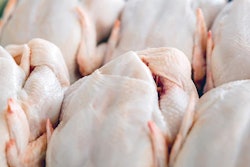
The effects of the growing trade conflict between the world’s two largest economies and the market repercussions of a near-peak supply of animal protein will play leading roles in the economic fortunes of 2019, according to a leading economist.
As part of the National Chicken Council’s Annual Conference, Will Sawyer, lead animal protein economist for CoBank, reviewed key economic trends affecting the recent past and near future of animal protein on October 31, 2018.
The U.S. China trade conflict
The past year was defined by international trade issues as the Trump Administration made a point to re-assess and re-negotiate the country’s relationship with its largest trading partners. The most significant dispute is the ongoing, so-called trade war between the U.S. and China.
Sawyer said the conflict could be seen as a short term pain for a long term gain for animal protein. Over the long term it could actually force China to the bargaining table and potentially yield a fairer trading relationship concerning the animal protein market.
The role of African Swine Fever
In 2018, the world’s two largest economies exchanged tit-for-tat, retaliatory tariffs which Sawyer said are affecting the U.S. animal protein market – particularly for pork. However, he said the country’s on-going challenges handling African Swine Fever (ASF) could be what pressures the Chinese to make a deal to open access to the market or create a more favorable environment for U.S. protein exports.
“As the Chinese deal with (ASF) – it’s not just going to be this quarter or 2019, it may be a long term issue – I think pork imports are going to be the variable they go to rather than trading down to chicken,” Sawyer said. “What does that mean? I think that in the end that brings a better conversation between the US and China.”
However, the resolve of the Chinese to keep up the fight shouldn’t be underestimated. The economist cited a recent presentation by Singaporean agribusiness group Wilmar International Limited which said the Chinese people are resolved to support their government in a prolonged trade conflict.
“This is about a long term issue, an issue that has been kind of bubbling for a number of years and I think that this is the time that we’re going to have to hash that out,” he said. “We’re going to have to find out ourselves: Can we bring the Chinese to a more fair way of doing business?”

Will Sawyer, CoBank | Photo by Austin Alonzo
The domestic protein supply
The chicken industry is already anticipating significant growth in national output as more plants are slated to come online in the coming years, but Sawyer said other animal proteins are facing a similar situation, too. Collectively, the beef, pork and chicken supply grew more in the past four years than they had in the previous 15 years.
The U.S. protein market made major strides to recover from the 2008-2009 recession and the down years, 2010-2013, that followed. Sawyer projects the overall growth of protein supply will slow. This will happen because: broiler weights are steadily increasing while the weight of other animals are not and animal numbers are high and potentially reaching their cap.
Focusing on chicken
With integrators committed to expansion, CoBank forecasts chicken production capacity will increase by 11 percent from 2018 to 2020. He said that figure doesn’t include weights or rationalization of existing poultry plants.
Sawyer did point out that the industry’s on-going challenges with finding labor for processing makes this the perfect opportunity to rationalize – or increase efficiency by better use of existing resources and by replacing manpower with machinery – the supply chain. It remains to be seen how this will play out in the coming 18 months.
One final factor to consider is the U.S. per capita meat consumption level. Consumption dipped during the recession and the following years, but it eventually recovered and was projected to surpass pre-recession consumption by the end of 2018.
“We’re going to set a new high in U.S. meat consumption,” Sawyer said. “Where do we go once we go beyond 202 pounds? Do we go to 205? Or do we see this battle between the proteins? That to me is the billion-dollar question.”
Read more:
US-China trade war: How did it all start?, www.wattagnet.com/articles/35877















